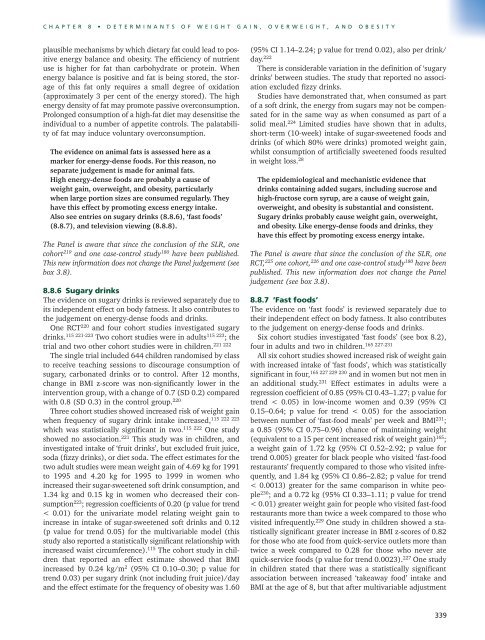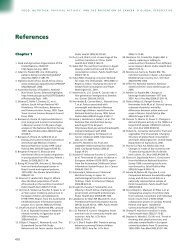Full Report - Food, Nutrition, and the Prevention of Cancer
Full Report - Food, Nutrition, and the Prevention of Cancer
Full Report - Food, Nutrition, and the Prevention of Cancer
You also want an ePaper? Increase the reach of your titles
YUMPU automatically turns print PDFs into web optimized ePapers that Google loves.
CHAPTER 8 • DETERMINANTS OF WEIGHT GAIN, OVERWEIGHT, AND OBESITY<br />
plausible mechanisms by which dietary fat could lead to positive<br />
energy balance <strong>and</strong> obesity. The efficiency <strong>of</strong> nutrient<br />
use is higher for fat than carbohydrate or protein. When<br />
energy balance is positive <strong>and</strong> fat is being stored, <strong>the</strong> storage<br />
<strong>of</strong> this fat only requires a small degree <strong>of</strong> oxidation<br />
(approximately 3 per cent <strong>of</strong> <strong>the</strong> energy stored). The high<br />
energy density <strong>of</strong> fat may promote passive overconsumption.<br />
Prolonged consumption <strong>of</strong> a high-fat diet may desensitise <strong>the</strong><br />
individual to a number <strong>of</strong> appetite controls. The palatability<br />
<strong>of</strong> fat may induce voluntary overconsumption.<br />
The evidence on animal fats is assessed here as a<br />
marker for energy-dense foods. For this reason, no<br />
separate judgement is made for animal fats.<br />
High energy-dense foods are probably a cause <strong>of</strong><br />
weight gain, overweight, <strong>and</strong> obesity, particularly<br />
when large portion sizes are consumed regularly. They<br />
have this effect by promoting excess energy intake.<br />
Also see entries on sugary drinks (8.8.6), ‘fast foods’<br />
(8.8.7), <strong>and</strong> television viewing (8.8.8).<br />
The Panel is aware that since <strong>the</strong> conclusion <strong>of</strong> <strong>the</strong> SLR, one<br />
cohort 219 <strong>and</strong> one case-control study 180 have been published.<br />
This new information does not change <strong>the</strong> Panel judgement (see<br />
box 3.8).<br />
8.8.6 Sugary drinks<br />
The evidence on sugary drinks is reviewed separately due to<br />
its independent effect on body fatness. It also contributes to<br />
<strong>the</strong> judgement on energy-dense foods <strong>and</strong> drinks.<br />
One RCT220 <strong>and</strong> four cohort studies investigated sugary<br />
drinks. 115 221-223 Two cohort studies were in adults115 223 ; <strong>the</strong><br />
trial <strong>and</strong> two o<strong>the</strong>r cohort studies were in children.<br />
221 222<br />
The single trial included 644 children r<strong>and</strong>omised by class<br />
to receive teaching sessions to discourage consumption <strong>of</strong><br />
sugary, carbonated drinks or to control. After 12 months,<br />
change in BMI z-score was non-significantly lower in <strong>the</strong><br />
intervention group, with a change <strong>of</strong> 0.7 (SD 0.2) compared<br />
with 0.8 (SD 0.3) in <strong>the</strong> control group. 220<br />
Three cohort studies showed increased risk <strong>of</strong> weight gain<br />
when frequency <strong>of</strong> sugary drink intake increased,<br />
115 222 223<br />
which was statistically significant in two. 115 222 One study<br />
showed no association. 221 This study was in children, <strong>and</strong><br />
investigated intake <strong>of</strong> ‘fruit drinks’, but excluded fruit juice,<br />
soda (fizzy drinks), or diet soda. The effect estimates for <strong>the</strong><br />
two adult studies were mean weight gain <strong>of</strong> 4.69 kg for 1991<br />
to 1995 <strong>and</strong> 4.20 kg for 1995 to 1999 in women who<br />
increased <strong>the</strong>ir sugar-sweetened s<strong>of</strong>t drink consumption, <strong>and</strong><br />
1.34 kg <strong>and</strong> 0.15 kg in women who decreased <strong>the</strong>ir consumption<br />
223 ; regression coefficients <strong>of</strong> 0.20 (p value for trend<br />
< 0.01) for <strong>the</strong> univariate model relating weight gain to<br />
increase in intake <strong>of</strong> sugar-sweetened s<strong>of</strong>t drinks <strong>and</strong> 0.12<br />
(p value for trend 0.05) for <strong>the</strong> multivariable model (this<br />
study also reported a statistically significant relationship with<br />
increased waist circumference). 115 The cohort study in children<br />
that reported an effect estimate showed that BMI<br />
increased by 0.24 kg/m 2 (95% CI 0.10–0.30; p value for<br />
trend 0.03) per sugary drink (not including fruit juice)/day<br />
<strong>and</strong> <strong>the</strong> effect estimate for <strong>the</strong> frequency <strong>of</strong> obesity was 1.60<br />
(95% CI 1.14–2.24; p value for trend 0.02), also per drink/<br />
day. 222<br />
There is considerable variation in <strong>the</strong> definition <strong>of</strong> ‘sugary<br />
drinks’ between studies. The study that reported no association<br />
excluded fizzy drinks.<br />
Studies have demonstrated that, when consumed as part<br />
<strong>of</strong> a s<strong>of</strong>t drink, <strong>the</strong> energy from sugars may not be compensated<br />
for in <strong>the</strong> same way as when consumed as part <strong>of</strong> a<br />
solid meal. 224 Limited studies have shown that in adults,<br />
short-term (10-week) intake <strong>of</strong> sugar-sweetened foods <strong>and</strong><br />
drinks (<strong>of</strong> which 80% were drinks) promoted weight gain,<br />
whilst consumption <strong>of</strong> artificially sweetened foods resulted<br />
in weight loss. 28<br />
The epidemiological <strong>and</strong> mechanistic evidence that<br />
drinks containing added sugars, including sucrose <strong>and</strong><br />
high-fructose corn syrup, are a cause <strong>of</strong> weight gain,<br />
overweight, <strong>and</strong> obesity is substantial <strong>and</strong> consistent.<br />
Sugary drinks probably cause weight gain, overweight,<br />
<strong>and</strong> obesity. Like energy-dense foods <strong>and</strong> drinks, <strong>the</strong>y<br />
have this effect by promoting excess energy intake.<br />
The Panel is aware that since <strong>the</strong> conclusion <strong>of</strong> <strong>the</strong> SLR, one<br />
RCT, 225 one cohort, 226 <strong>and</strong> one case-control study 180 have been<br />
published. This new information does not change <strong>the</strong> Panel<br />
judgement (see box 3.8).<br />
8.8.7 ‘Fast foods’<br />
The evidence on ‘fast foods’ is reviewed separately due to<br />
<strong>the</strong>ir independent effect on body fatness. It also contributes<br />
to <strong>the</strong> judgement on energy-dense foods <strong>and</strong> drinks.<br />
Six cohort studies investigated ‘fast foods’ (see box 8.2),<br />
four in adults <strong>and</strong> two in children.<br />
165 227-231<br />
All six cohort studies showed increased risk <strong>of</strong> weight gain<br />
with increased intake <strong>of</strong> ‘fast foods’, which was statistically<br />
significant in four, 165 227 229 230 <strong>and</strong> in women but not men in<br />
an additional study. 231 Effect estimates in adults were a<br />
regression coefficient <strong>of</strong> 0.85 (95% CI 0.43–1.27; p value for<br />
trend < 0.05) in low-income women <strong>and</strong> 0.39 (95% CI<br />
0.15–0.64; p value for trend < 0.05) for <strong>the</strong> association<br />
between number <strong>of</strong> ‘fast-food meals’ per week <strong>and</strong> BMI 231 ;<br />
a 0.85 (95% CI 0.75–0.96) chance <strong>of</strong> maintaining weight<br />
(equivalent to a 15 per cent increased risk <strong>of</strong> weight gain) 165 ;<br />
a weight gain <strong>of</strong> 1.72 kg (95% CI 0.52–2.92; p value for<br />
trend 0.005) greater for black people who visited ‘fast-food<br />
restaurants’ frequently compared to those who visited infrequently,<br />
<strong>and</strong> 1.84 kg (95% CI 0.86–2.82; p value for trend<br />
< 0.0013) greater for <strong>the</strong> same comparison in white people<br />
230 ; <strong>and</strong> a 0.72 kg (95% CI 0.33–1.11; p value for trend<br />
< 0.01) greater weight gain for people who visited fast-food<br />
restaurants more than twice a week compared to those who<br />
visited infrequently. 229 One study in children showed a statistically<br />
significant greater increase in BMI z-scores <strong>of</strong> 0.82<br />
for those who ate food from quick-service outlets more than<br />
twice a week compared to 0.28 for those who never ate<br />
quick-service foods (p value for trend 0.0023). 227 One study<br />
in children stated that <strong>the</strong>re was a statistically significant<br />
association between increased ‘takeaway food’ intake <strong>and</strong><br />
BMI at <strong>the</strong> age <strong>of</strong> 8, but that after multivariable adjustment<br />
339



